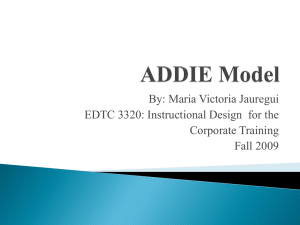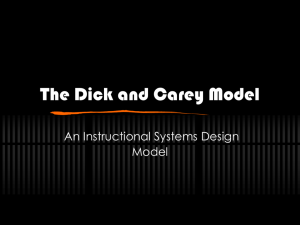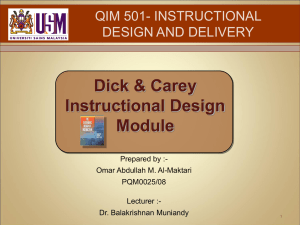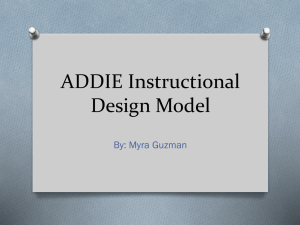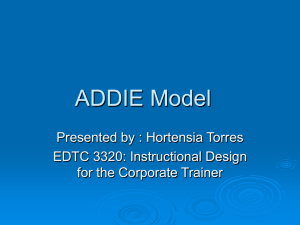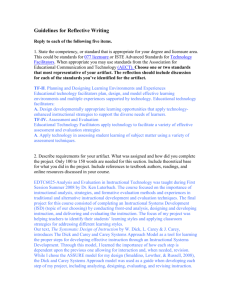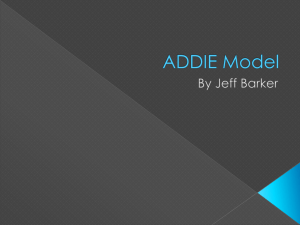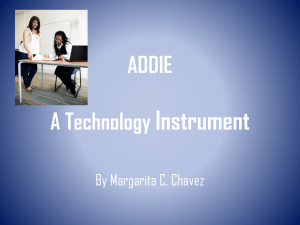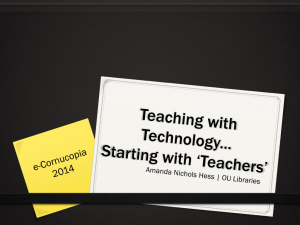Rapid Prototyping
advertisement
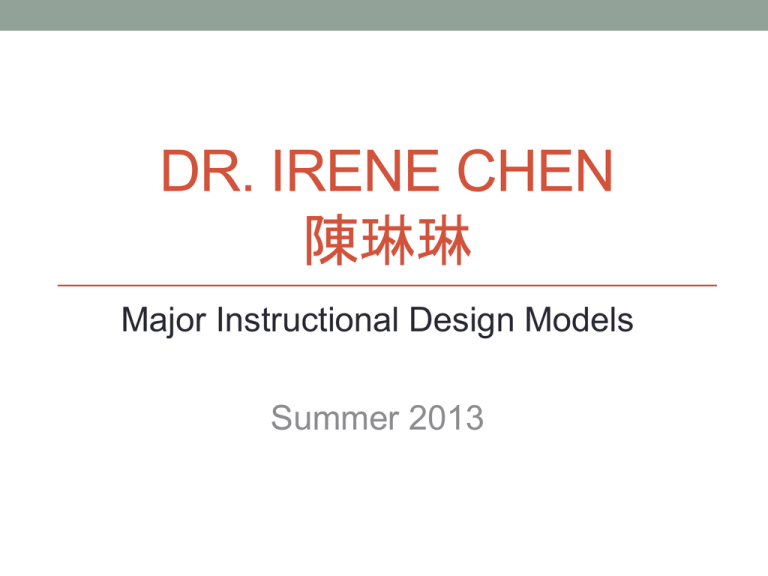
DR. IRENE CHEN 陳琳琳 Major Instructional Design Models Summer 2013 Timeline of Instructional Media 1950s to mid-1960s Television Growth of Instructional television Computer-assisted instruction (CAI) research started in the 1950s, became popular in the 1980s a few years after computer s became available to general public. The internet offered opportunities to train many people long distances. Desktop simulation gave advent to levels of Interactive Multimedia Instruction (IMI). 1950s-1990s Computer 1990s-2000s Internet, Simulation 2000s-2010s On-demand training moved to people's personal devices; Mobile Devices, Social Media social media allowed for collaborative learning. Instructional Design Theories & Models模型 • http://en.wikipedia.org/wiki/Instructional_design#ADDIE_p rocess Learning Domains 学习领域 Learning Outcomes 学习成果 • Benjamin Bloom and Robert Gagnè • Cognitive Domain認知領域 • Verbal information • Intellectual skills - label or classify the concepts • Intellectual skills - to apply the rules and principles • Intellectual skills - problem solving allows generating solutions or procedures • Cognitive strategies - are used for learning • Affective Domain情感領域 • Attitudes - are demonstrated by preferring options • Psychomotor Domain技能領域 • Motor skills - enable physical performance Instructional Design Models • Rapid prototyping • Dick and Carey • Instructional Development Learning System (IDLS) • Other instructional design models • ADDIE process ADDIE • ADDIE (Analysis, Design, Development, Implementation, and Evaluation) Model: an instructional design model that represents a flexible guideline for constructing effective training support tools ADDIE • Florida State University to explain the processes involved • • • • in the formulation of an instructional systems development (ISD) program for military interservice training The version as we understand it today appeared in the mid-80s Connecting all phases of the model are external and reciprocal revision opportunities Aside from the internal Evaluation phase, revisions should and can be made throughout the entire process. Each phase in this model is done in a linear method. Rapid Prototyping • A group of techniques used to quickly fabricate a scale model of a physical part or assembly using threedimensional CAD data. • The first techniques for rapid prototyping became available in the late 1980s and were used to produce models and prototype parts • With Rapid Prototyping the ADDIE model is not used as designed. It typically has several steps merged together to streamline the process. Rapid Prototyping • Used under these constraints: • Time • Budget • Environmental restraints • Disadvantage: • Some researchers believe that many important steps of instructional design are forfeited for a faster, cheaper model. • Many problems may be overlooked and result in endless revision. • Advantage: • The needs are clearly expressed from the beginning. • The user is able to offer immediate feedback which results in a better product. • Its non-linear approach allows for more flexibility in the instruction and can catch problems early in the development stages. • RP reduces development time and costs. Rapid Prototyping Rapid Prototyping should not be used by a novice, because even though it cuts out steps of ADDIE, the designer still must have knowledge of the whole process.外行勿試 Dick and Carey • Walter Dick • Lou Carey • James O. Carey • Walter Dick • PhD from Penn State University in Educational Psychology • Studied with Robert Gagne' • Emeritus Professor from Florida State University • Lou Carey • PhD from Florida State University • Studied with Robert Gagne' and Walter Dick • Arizona State University Dick and Carey • Stage 1. Instructional Goals • Stage 2. Instructional Analysis • Stage 3. Entry Behaviors and Learner Characteristics • Stage 4. Performance Objectives • Stage 5. Criterion-Referenced Test Items • Stage 6. Instructional Strategy • Stage 7. Instructional Materials • Stage 8. Formative Evaluation • Stage 9. Summative Evaluation Dick and Carey • Dick and Carey (1996) pointed out the systematic characteristics of their model: • Goal-directed: all the components in the system work together toward a defined goal • Interdependencies: all the components in the system depend on each other for input and output. • Feedback mechanism: the entire system uses feedback to determine whether the goal is met. • Self-regulating: The system will be modified until the desired goal is reached. • Jerry Willis(2009), editor of the book, Constructivist Instructional Design (C-ID): Foundations, Models and Examples, sees current Instructional Design (ID) as moving in opposite directions. • First, there is a traditional ID that focuses on a linear method of design. • The ADDIE Model and, more specifically, the Dick and Carey Model of Instructional Systems Design(ISD) are examples. • These models are based on learning theories of the behavioral and cognitive families. • ID based on constructivist learning theory R2D2 Jerry Willis The Outcome of Two Foundational Theories on Instructional Design (Willis, 2009c) Characteristics of Objective-Rational ID Models Characteristics of ConstructivistInterpretivist ID Models 1.The process is sequential and linear 2.Planning is top-down and “systematic” 3.Objectives guide development 4.Experts, who have special knowledge, are critical to ID work 5.Careful sequencing and teaching of sub skills are important 6.The goal is delivery of preselected knowledge 7.Summative evaluation is critical 8.Objective data are critical 1.The ID process is recursive, nonlinear, and sometimes chaotic 2.Planning is organic, developmental, reflective and collaborative 3.Objectives emerge from design and development work 4.General ID experts don’t exist 5.Instruction emphasizes learning in meaningful contexts 6.“Formative” evaluation is critical 7.Subjective data may be the most valuable R2D2 Basic Principles • Recursion – the steps taken in design need not follow a linear or waterfall sequence. The design problem should be able to be accessed from any angle at any time any number of times in any order. The situation or context determines the necessary steps, not the expert designer. • Reflection – this is a continual cycle in framing the problems that occur in the design process, improvising a solution and finally implementing the solution. • Participatory Design – all stakeholders, including students, need to be included in every aspect of the design process. The collective knowledge can be applied to produce more meaningful instruction. Information sources: • http://www.wikipedia.org/ • http://etec.ctlt.ubc.ca/510wiki/The_R2D2_Model_of_Instru ctional_Design • http://edutechwiki.unige.ch/en/

